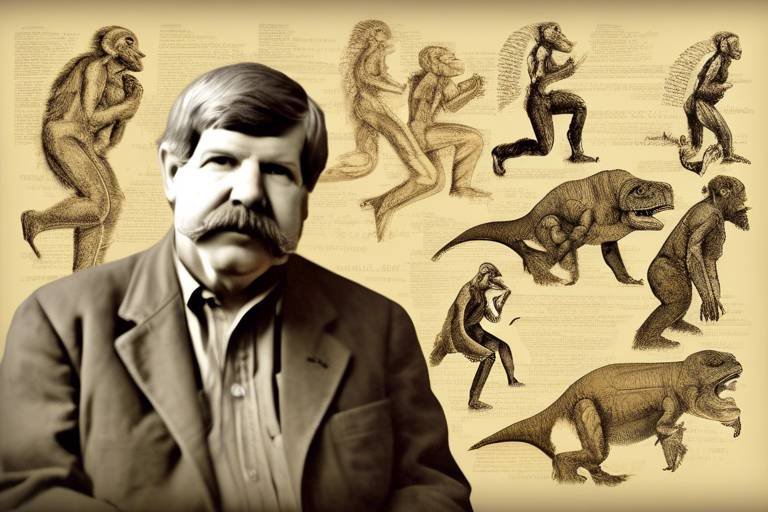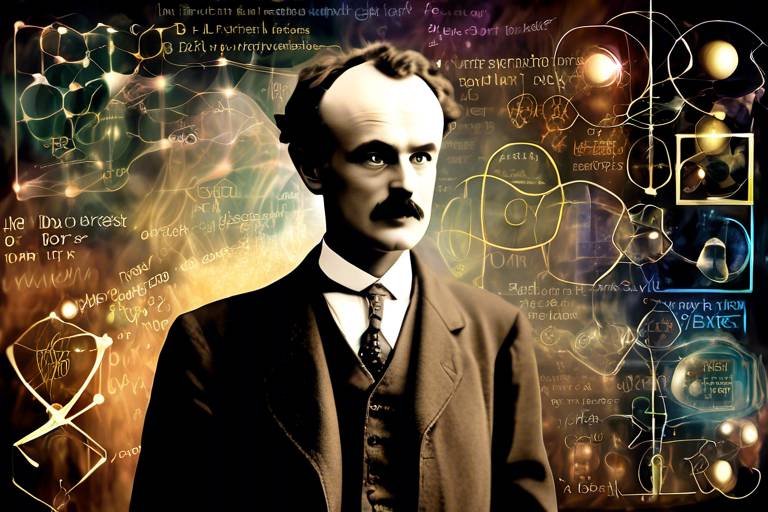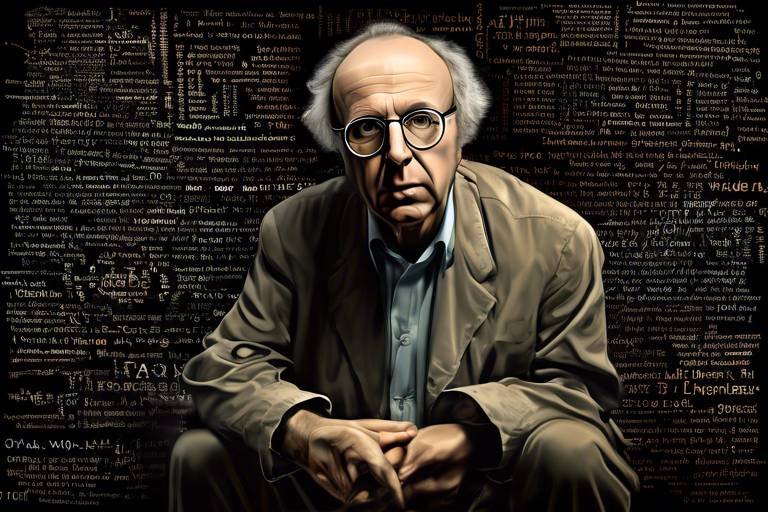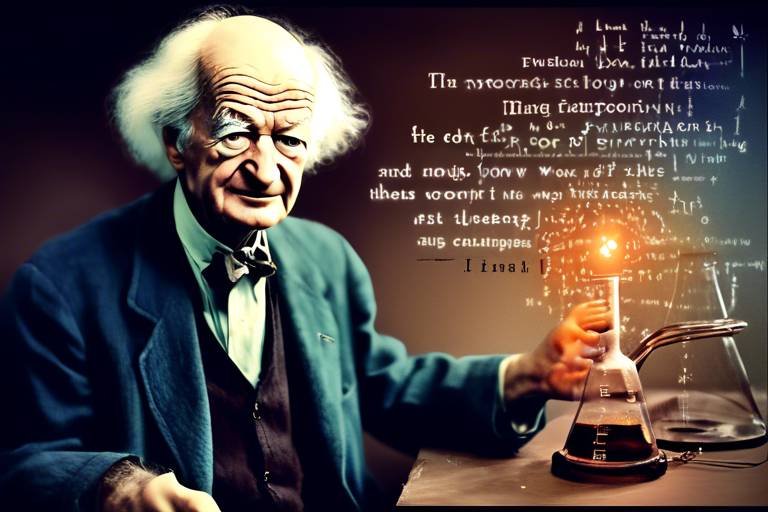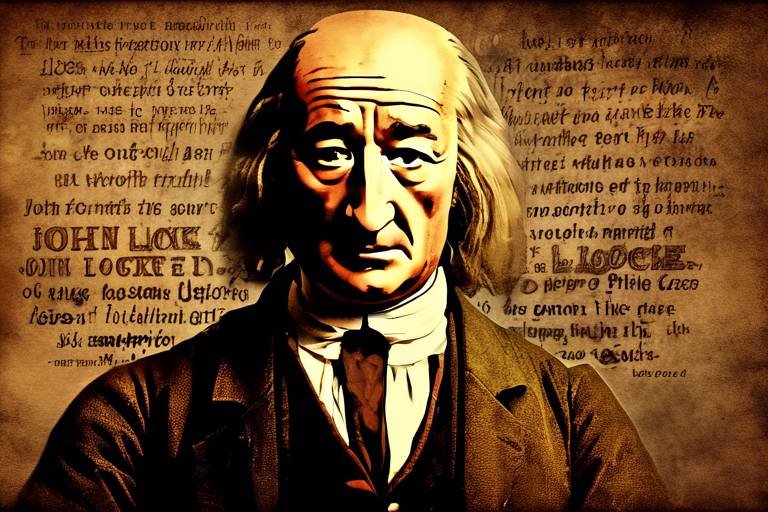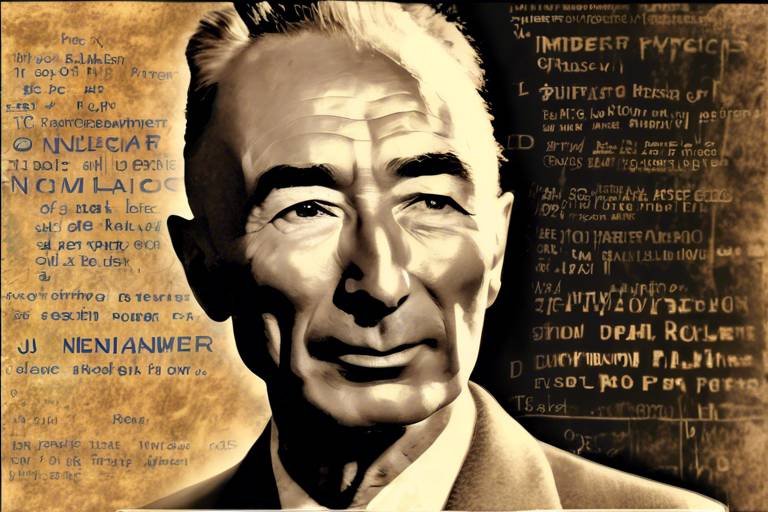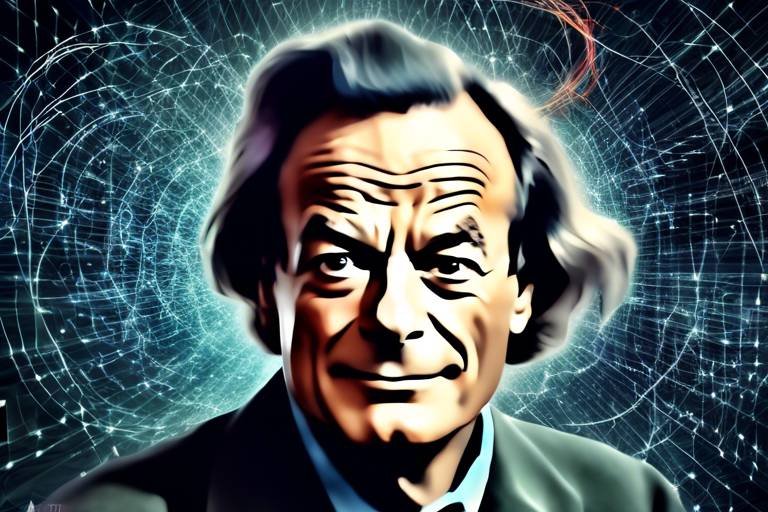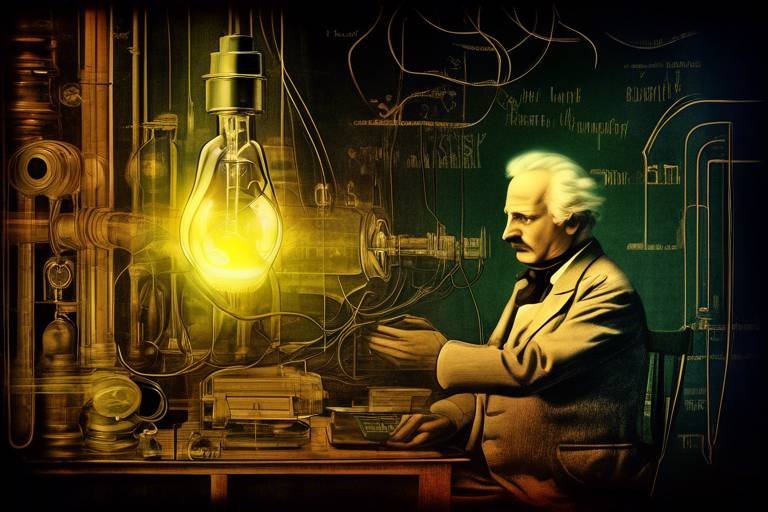The Life of Albert Einstein and His Impact on Science
Albert Einstein is not just a name; he is a legend in the world of science, a beacon of intellect that has illuminated the path of physics for generations. Born on March 14, 1879, in Ulm, Germany, Einstein's journey from a curious child to a groundbreaking physicist is nothing short of extraordinary. His contributions to science, particularly in the realms of theoretical physics, have reshaped our understanding of the universe and have had profound implications on modern science and technology.
Einstein's work is often viewed as a revolution in thought, challenging long-held beliefs and introducing concepts that were previously unimaginable. His theories, especially those of relativity, have not only altered the fabric of physics but have also influenced various fields such as astronomy, cosmology, and even philosophy. Imagine standing on the precipice of knowledge, peering into the vast unknown, and discovering that time is not a constant but a fluid entity that can bend and warp! This was the essence of Einstein's genius.
His most famous equation, Emc², is a testament to his ability to distill complex ideas into simple, yet powerful, expressions. It encapsulates the relationship between mass and energy, revealing how they are interchangeable. This insight paved the way for advancements in nuclear energy and has had far-reaching implications, from powering cities to the devastating effects of atomic bombs. Einstein’s work is a reminder that with great knowledge comes great responsibility, a theme that resonates through his life and legacy.
Beyond the equations and theories, Einstein was a man of deep conviction and humanity. He used his platform to advocate for peace, civil rights, and education, believing that science should serve the greater good of society. His life story is not just about scientific achievements; it’s a narrative of a thinker who was deeply concerned about the world around him. As we delve deeper into his life and work, we uncover not just the mind of a genius but the heart of a humanitarian.
In the following sections, we will explore Einstein's early life, his revolutionary theories, and the lasting impact he has had on both science and society. Each aspect of his journey offers a glimpse into the mind of a man who dared to challenge the status quo and forever changed the way we perceive the universe.
- What are Einstein's most significant contributions to science? Einstein is best known for his theories of relativity, the photoelectric effect, and his work in quantum mechanics.
- How did Einstein's theories change our understanding of the universe? His theories introduced concepts such as time dilation and the curvature of spacetime, fundamentally altering our understanding of gravity and motion.
- What was Einstein's stance on nuclear weapons? Einstein was a strong advocate for peace and expressed regret over his role in the development of nuclear weapons, emphasizing the need for responsible use of scientific knowledge.
- How is Einstein viewed in popular culture today? Einstein has become a symbol of genius and creativity, often depicted in media as the archetypal scientist.

Early Life and Education
Albert Einstein was born on March 14, 1879, in Ulm, Germany, into a middle-class Jewish family. His father, Hermann Einstein, was a salesman and engineer, while his mother, Pauline Koch, was a homemaker. From a young age, Einstein exhibited an insatiable curiosity about the world around him, often questioning the nature of reality. His early education began at a local primary school, where he quickly developed a love for mathematics and science. However, it wasn't all smooth sailing; Einstein struggled with the rigid educational system of the time, which stifled his creativity and independent thinking.
At the age of 10, Einstein's family moved to Munich, where he enrolled in the Luitpold Gymnasium. Here, he faced challenges due to the authoritarian teaching style, which clashed with his desire for freedom in learning. Despite these obstacles, he excelled in subjects like mathematics and physics, often spending hours immersed in books on advanced topics. His passion for learning was ignited by a compass gifted to him by his father, which sparked a lifelong fascination with the forces of nature.
After struggling to adapt to the strict educational environment, Einstein left the Gymnasium at the age of 15 and moved to Switzerland. He enrolled in the Swiss Federal Polytechnic Institute in Zurich, where he studied physics and mathematics. It was during these formative years that Einstein truly began to flourish, surrounded by like-minded individuals who shared his passion for inquiry and exploration. His professors recognized his brilliance, yet Einstein often felt out of place among his peers, who were more socially adept.
Einstein's time at the Polytechnic was marked by both personal and academic growth. He developed a close friendship with fellow student Mileva Marić, who would later become his first wife. Together, they engaged in deep discussions about science and philosophy, challenging each other's ideas and pushing the boundaries of their understanding. This partnership would prove influential in shaping Einstein's later theories, as Marić was instrumental in providing him with support and encouragement during his early career.
Upon graduating in 1900, Einstein faced a challenging job market. He struggled to find a position in academia, leading him to take a job as a patent examiner at the Swiss Patent Office. While this role may seem mundane, it provided him with the financial stability and time to pursue his scientific interests. During this period, he developed several groundbreaking theories that would eventually revolutionize the field of physics.
In summary, Einstein's early life and education were characterized by a blend of curiosity, struggle, and resilience. His formative years in Germany and Switzerland laid the groundwork for his future contributions to science. The challenges he faced in traditional educational settings only fueled his desire to explore the mysteries of the universe, ultimately leading him to become one of the most influential scientists in history.
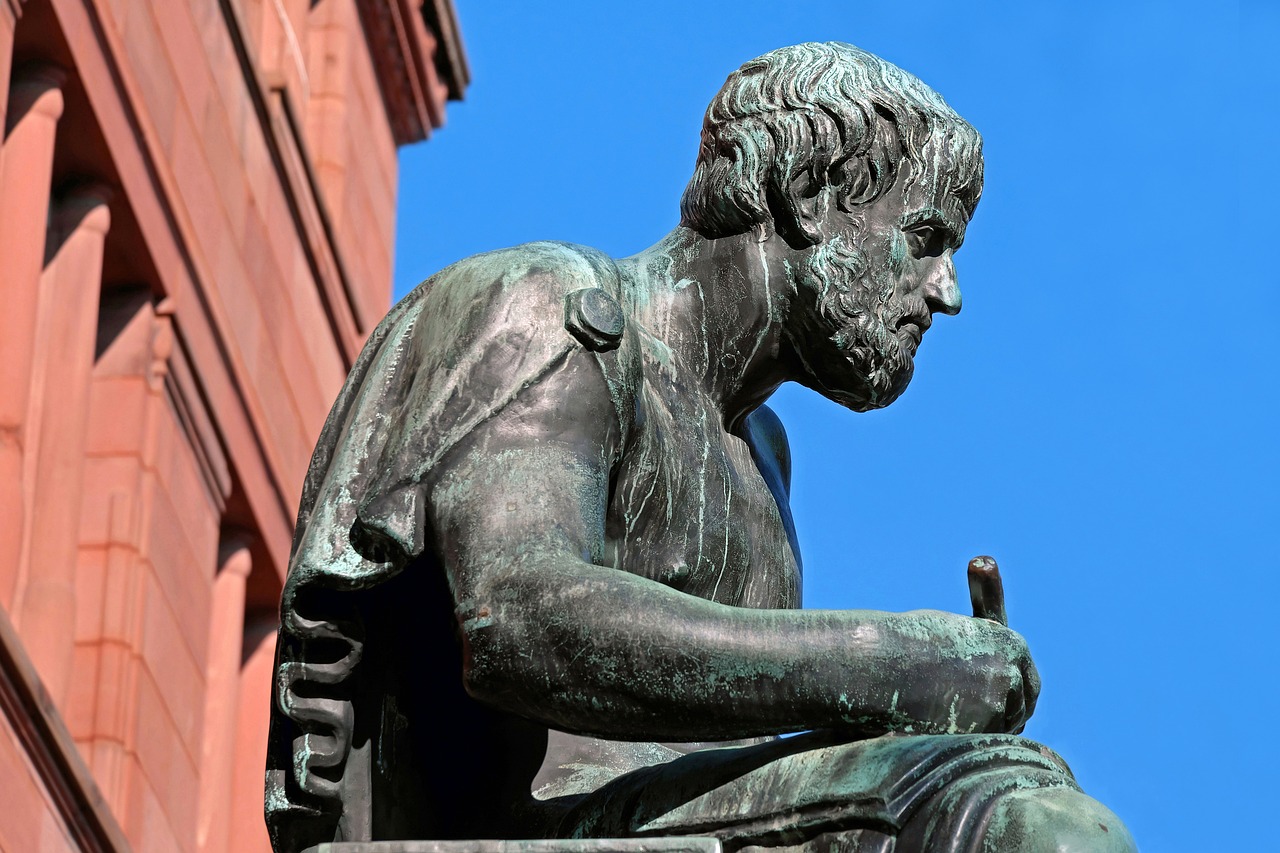
Revolutionary Theories
Albert Einstein's contributions to physics are nothing short of revolutionary. His theories not only reshaped our understanding of the universe but also ignited a spark of curiosity and inquiry that continues to inspire scientists today. At the heart of Einstein's legacy are two monumental theories: Special Relativity and General Relativity. Together, these theories challenge our intuitive perceptions of space, time, and gravity, leading to groundbreaking insights into the fabric of reality.
Einstein's work can be likened to a cosmic puzzle, where each piece reveals a deeper understanding of how the universe operates. Imagine trying to solve a jigsaw puzzle without knowing the picture on the box; that’s how physicists approached the cosmos before Einstein. With his theories, he provided the missing pieces that allowed us to see a more complete picture. Let's dive deeper into these revolutionary concepts.
Introduced in 1905, Special Relativity revolutionized the concepts of space and time. Prior to Einstein, scientists believed that time was absolute and unchanging. However, Einstein proposed that time is relative and can be affected by the speed at which an object is moving. This idea was encapsulated in two key postulates:
- The laws of physics are the same for all observers, regardless of their relative motion.
- The speed of light in a vacuum is constant and will always measure the same for all observers, no matter their motion.
This radical shift in thinking led to numerous counterintuitive implications, such as the phenomenon of time dilation. Imagine a twin who travels in a spaceship at near-light speed while the other remains on Earth; upon returning, the traveling twin would be younger than the one who stayed behind! This concept isn't just theoretical; it has practical applications in technologies like GPS, where satellite clocks must account for time dilation effects to provide accurate positioning.
Time dilation is one of the most astonishing consequences of special relativity. It reveals how time can stretch and compress depending on an observer's speed. This means that if you were to travel at a significant fraction of the speed of light, you could experience time at a different rate than someone who remained stationary. This concept can be illustrated using a simple table:
| Speed of Observer | Time Experienced (1 Year) | Time Passed on Earth |
|---|---|---|
| Stationary | 1 Year | 1 Year |
| Near Light Speed | 1 Year | Many Years |
This fascinating aspect of relativity not only challenges our intuitive understanding of time but also opens up discussions about the nature of reality itself.
Another groundbreaking idea from special relativity is the concept of mass-energy equivalence, famously expressed in the equation Emc². This equation asserts that mass can be converted into energy and vice versa, fundamentally changing how we view matter and energy. It illustrates that a small amount of mass can be transformed into a tremendous amount of energy, which is the principle behind nuclear reactions. This relationship has profound implications, not just in theoretical physics but also in practical applications like nuclear power and medicine.
Building upon his earlier work, Einstein published his General Theory of Relativity in 1915, which expanded our understanding of gravity. Unlike Newton's view of gravity as a force acting at a distance, Einstein proposed that gravity is the result of the curvature of spacetime caused by mass. Picture a heavy bowling ball placed on a trampoline; the ball creates a dip in the surface, causing smaller objects to roll towards it. This analogy illustrates how massive objects like planets and stars warp the fabric of spacetime, influencing the paths of other objects.
Einstein's theories have not only transformed physics but have also paved the way for modern advancements in cosmology, astrophysics, and beyond. His revolutionary ideas continue to inspire scientists and thinkers to explore the mysteries of the universe, proving that the quest for knowledge is indeed limitless.
- What is special relativity? Special relativity is a theory proposed by Einstein that describes the relationship between space and time, asserting that time is relative and can vary for observers in different states of motion.
- What does Emc² mean? Emc² is Einstein's equation that expresses the equivalence of mass and energy, indicating that mass can be converted into energy and vice versa.
- How did general relativity change our understanding of gravity? General relativity redefined gravity as the curvature of spacetime caused by mass, rather than a force acting at a distance, altering our perception of how objects interact in the universe.

Special Relativity
Introduced in 1905, was nothing short of a revolution in the world of physics. Imagine being told that everything you thought you knew about space and time was about to change dramatically! That's exactly what Einstein did with this groundbreaking theory. He proposed that the laws of physics are the same for all non-accelerating observers, and he introduced the idea that the speed of light is constant, regardless of the motion of the light source or observer. This was a radical departure from the classical Newtonian mechanics that had dominated scientific thought for centuries.
At the heart of special relativity are two key postulates: first, the principle of relativity, which states that the laws of physics are invariant in all inertial frames of reference; and second, the constancy of the speed of light in a vacuum, which is always approximately 299,792 kilometers per second (or about 186,282 miles per second). These concepts might sound straightforward, but they led to mind-bending implications that challenged our fundamental understanding of reality.
One of the most astonishing outcomes of special relativity is the phenomenon of time dilation. Picture this: if you were to travel in a spaceship at a significant fraction of the speed of light, time would pass differently for you compared to someone who remained on Earth. This means that if you took a journey through space at near-light speed, you could return home to find that many more years had passed on Earth than you experienced in your spaceship. It's like stepping into a time machine!
Moreover, another crucial aspect of special relativity is the concept of mass-energy equivalence, famously encapsulated in the equation Emc². This equation tells us that mass can be converted into energy and vice versa, fundamentally linking the two concepts. It's not just a theoretical idea; it has practical implications, particularly in the realm of nuclear physics. The energy released in nuclear reactions, such as those in the sun or atomic bombs, is a direct application of this principle. In a way, Einstein's equation is a reminder that the universe is far more interconnected than we often realize.
In summary, special relativity reshaped our understanding of the universe in profound ways. It challenged long-held beliefs, introduced new concepts like time dilation and mass-energy equivalence, and opened the door to further explorations in physics. As we delve deeper into Einstein's theories, we see how they not only transformed science but also our perception of reality itself.

Time Dilation
Time dilation is one of the most fascinating consequences of Einstein's theory of special relativity, and it challenges our intuitive understanding of time. Imagine you are at a party, and everyone is having a great time. Suddenly, you notice that your friend, who just got back from a trip to space, seems to have aged less than you! This isn't just a quirky observation; it's a fundamental aspect of how time works when you're moving at high speeds or in strong gravitational fields.
At its core, time dilation means that time can pass at different rates for observers who are in different frames of reference. For example, if you were to travel in a spaceship at a significant fraction of the speed of light, time would pass more slowly for you compared to someone who remained on Earth. This isn't science fiction; it's backed by experimental evidence! One of the most famous experiments involved highly accurate atomic clocks flown around the Earth on jets. When compared to stationary clocks, the flying clocks showed less elapsed time, confirming Einstein's predictions.
To better understand this concept, let's break it down into two main scenarios:
- Relative Velocity: When two observers are moving relative to each other, the one moving faster will experience time more slowly. This effect becomes more pronounced as their speed approaches the speed of light.
- Gravitational Time Dilation: According to general relativity, the stronger the gravitational field, the slower time passes. For instance, time runs slightly faster on the International Space Station than it does on Earth due to the weaker gravitational pull in space.
These effects may seem negligible at everyday speeds, but they become significant in high-speed scenarios, such as in particle accelerators or when considering cosmic phenomena. For instance, particles called muons, which are created when cosmic rays hit the Earth's atmosphere, have a very short lifespan. However, when they are moving close to the speed of light, they travel farther than they would if they were at rest, because time for them is dilated.
In conclusion, time dilation not only redefines our perception of time but also has practical implications in fields such as GPS technology, where satellite clocks must account for the effects of both velocity and gravity to provide accurate location data. So, the next time you hear someone say, "Time flies," remember that, according to Einstein, it might just be flying at different speeds for different observers!

Mass-Energy Equivalence
The concept of is encapsulated in one of the most famous equations in the world: Emc². This simple yet profound equation reveals a fundamental truth about the universe: mass and energy are interchangeable. It suggests that a small amount of mass can be converted into a large amount of energy. To put it simply, think of mass as a reservoir of energy waiting to be unleashed. Just like a dam holds back water, mass holds back energy that can be released under the right conditions.
Einstein's revelation came during a time when the scientific community was already grappling with the implications of his earlier work on special relativity. The equation implies that energy (E) is equal to mass (m) multiplied by the speed of light (c) squared. Since the speed of light is an incredibly large number (approximately 299,792,458 meters per second), even a tiny amount of mass can be converted into a tremendous amount of energy. This principle is the cornerstone of nuclear physics and has profound implications for both theoretical and practical applications.
For instance, in nuclear reactions, such as those occurring in the sun or in nuclear power plants, mass is converted into energy at a staggering rate. In the sun, hydrogen nuclei fuse to form helium, and in the process, a fraction of their mass is lost and converted into energy, which we perceive as sunlight. This process not only powers our sun but is also the reason why we have energy sources like nuclear power on Earth. The table below illustrates some comparisons of mass-energy conversion in various scenarios:
| Process | Mass Loss (kg) | Energy Released (Joules) |
|---|---|---|
| Fusion in the Sun | 4.1 x 10-12 | 3.7 x 1028 |
| Fission in Nuclear Reactor | 0.1 | 8.2 x 1013 |
| Antimatter Annihilation | 1 | 1.8 x 1017 |
The implications of Emc² extend beyond physics; they touch on the very fabric of our understanding of the universe. It challenges the conventional notions of mass and energy, suggesting that they are not separate entities but rather two sides of the same coin. This idea has led to countless innovations and advancements in technology, including the development of nuclear weapons and medical technologies such as PET scans, which utilize positron emission to detect diseases.
However, the mass-energy equivalence principle also raises ethical questions. The ability to unleash such vast amounts of energy from a small amount of mass has led to the creation of powerful weapons, prompting debates about responsibility and the consequences of scientific discovery. Just as Prometheus brought fire to humanity, Einstein's equation has given us the power to harness the fundamental forces of nature, but with that power comes the weight of responsibility.
In conclusion, mass-energy equivalence is not just a scientific principle; it is a profound insight into the nature of reality. It serves as a reminder of the interconnectedness of mass and energy and challenges us to consider the implications of our discoveries. As we continue to explore the universe, Einstein's equation will undoubtedly remain a guiding light, illuminating the path of scientific inquiry and innovation.
- What is mass-energy equivalence? It is the principle that mass can be converted into energy and vice versa, expressed by the equation Emc².
- How does mass-energy equivalence relate to nuclear energy? In nuclear reactions, a small amount of mass is converted into a large amount of energy, which powers nuclear reactors and the sun.
- What are the real-world applications of Emc²? Applications include nuclear power generation, medical imaging technologies, and understanding cosmic phenomena.

General Relativity
Einstein's general theory of relativity, introduced in 1915, was nothing short of revolutionary. It took the already groundbreaking ideas of his special relativity and expanded them to include gravity, fundamentally changing our understanding of the universe. Prior to this, gravity was viewed merely as a force acting at a distance, as described by Newton. However, Einstein proposed that gravity is not a force in the traditional sense but rather a curvature of spacetime caused by mass. Imagine placing a heavy ball on a stretched rubber sheet; the sheet bends, illustrating how massive objects like planets and stars warp the fabric of spacetime around them.
This theory opened up a plethora of new questions and insights. For instance, it explained why light bends when it passes near a massive object, an effect that was confirmed during a solar eclipse in 1919. The world was captivated by this revelation, as it not only validated Einstein’s theories but also showcased the profound connection between light and gravity. The implications of general relativity stretch far beyond mere academic curiosity; they have practical applications in technologies we use today, such as GPS systems. These systems must account for the effects of general relativity to provide accurate location data, as time runs slightly faster in satellites than on Earth due to the difference in gravitational pull.
To further illustrate how general relativity reshaped our understanding of the cosmos, consider the following table that highlights some of its key predictions and their confirmations:
| Prediction | Observation |
|---|---|
| Bending of Light | Confirmed during the 1919 solar eclipse |
| Gravitational Waves | Detected by LIGO in 2015 |
| Black Holes | Imaged by the Event Horizon Telescope in 2019 |
| Time Dilation in Gravity | Observed in experiments with atomic clocks |
Einstein's general relativity also provided a framework for understanding the dynamics of the universe itself. It led to the development of cosmological models that describe the expansion of the universe, paving the way for concepts like the Big Bang theory. This was a significant shift from the previously held notion of a static universe. Einstein himself even referred to his introduction of the cosmological constant—a term he later called his "greatest blunder"—to allow for a static universe, which he later abandoned as evidence for an expanding universe emerged.
In summary, general relativity is not just a theory; it's a profound shift in how we perceive the universe and our place within it. It has challenged and inspired generations of scientists, leading to a deeper understanding of phenomena such as black holes, gravitational waves, and the very fabric of spacetime. As we continue to explore the universe, Einstein's legacy lives on, reminding us that the quest for knowledge is a journey without end.

Contributions to Quantum Mechanics
Although Albert Einstein is often celebrated for his groundbreaking theories in relativity, his contributions to quantum mechanics are equally significant, albeit more complex. Initially, Einstein was skeptical of the emerging field of quantum mechanics, particularly the idea that particles could exist in multiple states simultaneously. He famously quipped, "God does not play dice with the universe," expressing his discomfort with the inherent randomness that quantum mechanics suggested. However, despite his reservations, Einstein's work laid critical groundwork for the field.
One of Einstein's most notable contributions to quantum mechanics is his explanation of the photoelectric effect. In 1905, he proposed that light can be thought of as discrete packets of energy, which he called "quanta" or photons. This was a radical departure from the classical wave theory of light and provided a new understanding of how light interacts with matter. The photoelectric effect demonstrated that when light shines on a metal surface, it can eject electrons from that surface, but only if the light's frequency exceeds a certain threshold. This finding was pivotal, as it confirmed the particle-like behavior of light and earned Einstein the Nobel Prize in Physics in 1921.
Furthermore, Einstein's ideas on quantum entanglement also played a crucial role in shaping modern physics. He described this phenomenon as "spooky action at a distance," highlighting his skepticism about the non-locality implied by quantum mechanics. Quantum entanglement occurs when two particles become interconnected, such that the state of one particle instantly affects the state of another, regardless of the distance separating them. This concept not only challenged classical intuitions about separability but also led to numerous experimental validations and applications in quantum computing and cryptography.
To summarize, Einstein's contributions to quantum mechanics, despite his initial skepticism, were instrumental in advancing the field. His work on the photoelectric effect and quantum entanglement opened new pathways for research and experimentation. The implications of his findings continue to resonate today, influencing everything from technology to our understanding of the universe. In the realm of quantum mechanics, Einstein's legacy is a testament to the complexity and beauty of the scientific endeavor.
- What is the photoelectric effect?
The photoelectric effect is the phenomenon where light can eject electrons from a material, demonstrating the particle-like properties of light.
- What did Einstein mean by "spooky action at a distance"?
This phrase refers to quantum entanglement, where two particles are linked in such a way that changes to one affect the other, no matter the distance apart.
- How did Einstein's work influence modern physics?
Einstein's theories laid the foundation for quantum mechanics and have influenced various fields, including quantum computing, cryptography, and our understanding of the fundamental nature of reality.
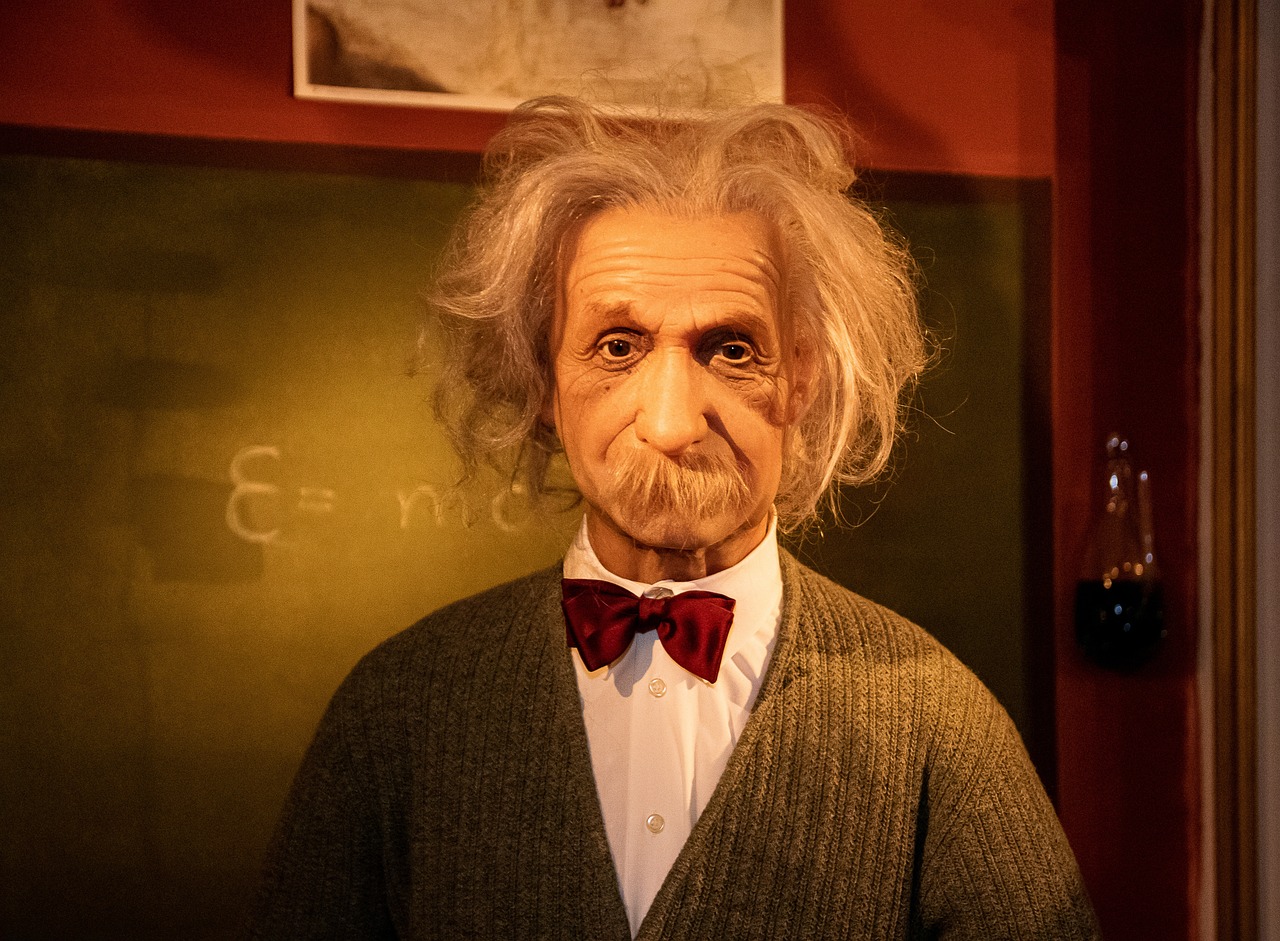
Photoelectric Effect
The is one of the cornerstone phenomena in quantum physics that fundamentally changed our understanding of light and matter. Discovered by Heinrich Hertz in 1887, it wasn't until Albert Einstein stepped onto the scene that we truly grasped its implications. In 1905, Einstein published his groundbreaking paper explaining this effect, for which he later received the Nobel Prize in Physics in 1921. But what exactly is the photoelectric effect, and why is it so important?
At its core, the photoelectric effect occurs when light, or electromagnetic radiation, hits a material and causes it to emit electrons. Imagine shining a flashlight on a metal surface. If the light has enough energy, it can knock electrons off the surface, creating a flow of electricity. This phenomenon challenges the classical wave theory of light, which suggested that light's energy should depend on its intensity, not its frequency. Einstein proposed that light is made up of quanta or photons, each carrying a discrete amount of energy determined by its frequency. This was a revolutionary idea that paved the way for the development of quantum mechanics.
To better understand the photoelectric effect, let's break down the key components:
| Component | Description |
|---|---|
| Photon | A particle of light that carries energy. |
| Threshold Frequency | The minimum frequency required to eject electrons from a material. |
| Work Function | The minimum energy needed to remove an electron from the surface of a material. |
This understanding of the photoelectric effect has profound implications for both theoretical physics and practical applications. For instance, it laid the groundwork for technologies like solar panels and photoelectric sensors. In solar panels, photons from sunlight strike the surface of the panel and excite electrons, generating electricity. Similarly, photoelectric sensors are used in various devices, from automatic doors to security systems, demonstrating how Einstein's insights continue to shape our world.
However, Einstein's explanation also sparked debates among scientists. Some, like Niels Bohr, embraced the quantum interpretation of light, while others were skeptical. Einstein famously referred to quantum entanglement as “spooky action at a distance,” showing his discomfort with the implications of quantum mechanics. Despite his reservations, the photoelectric effect remains a crucial piece of the puzzle in understanding the quantum world.
In summary, the photoelectric effect not only revolutionized our understanding of light but also opened the door to a multitude of technological advancements. It serves as a testament to Einstein's genius, demonstrating how a simple idea can lead to profound changes in both science and society.
- What is the photoelectric effect?
- Why is Einstein important to the photoelectric effect?
- What are some applications of the photoelectric effect?
The photoelectric effect is the phenomenon where light causes the emission of electrons from a material.
Einstein explained the photoelectric effect in 1905, proposing that light consists of particles called photons, which was crucial for the development of quantum mechanics.
Applications include solar panels, photoelectric sensors, and various electronic devices that rely on light to function.
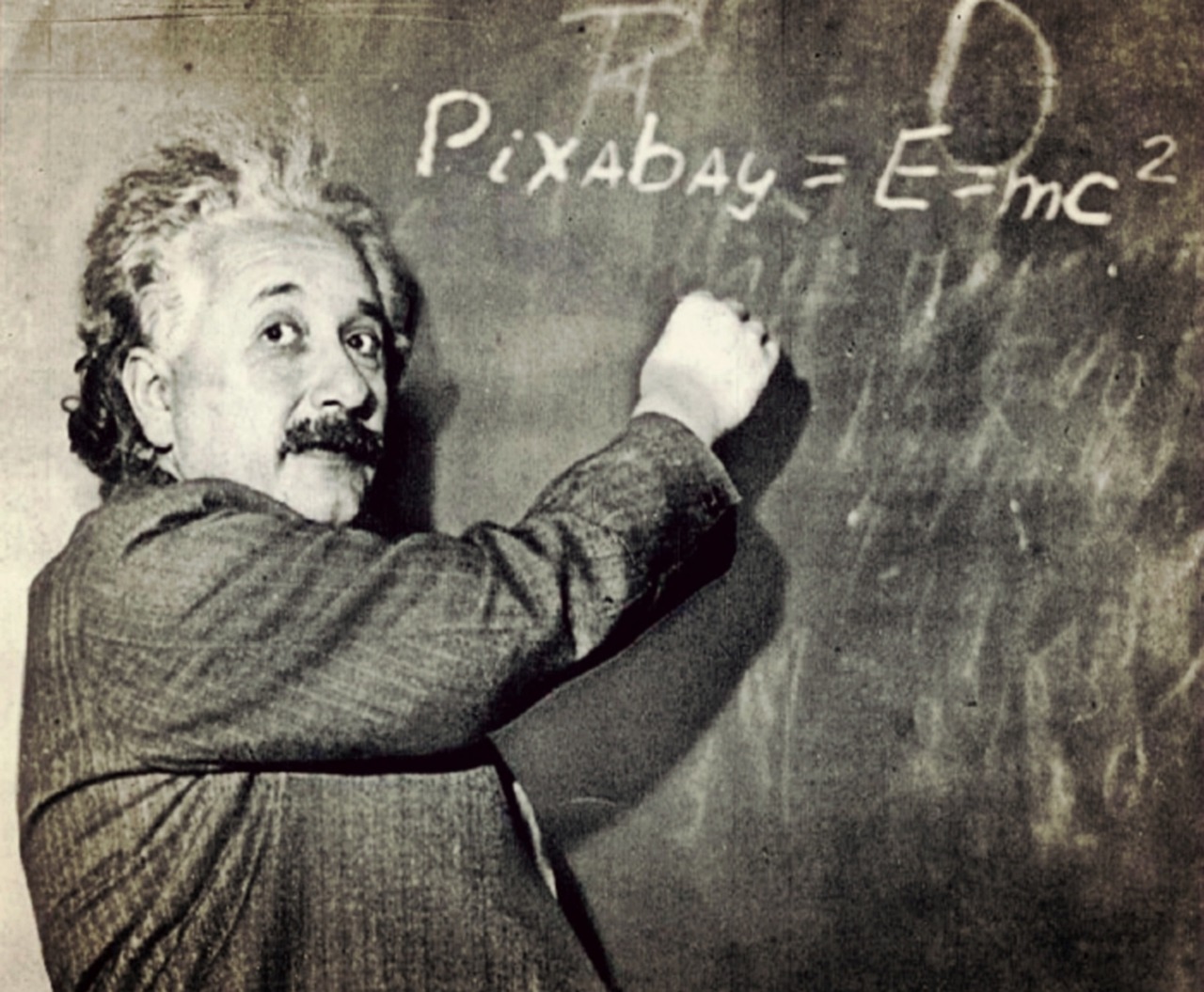
Quantum Entanglement
Quantum entanglement is one of the most fascinating and perplexing phenomena in the world of physics, and it’s a concept that even the great Albert Einstein struggled to fully accept. Often described as "spooky action at a distance," entanglement refers to a peculiar connection between particles that allows them to instantaneously affect each other's state, regardless of the distance separating them. Imagine having a pair of magic dice: no matter how far apart you roll them, if one shows a six, the other will immediately show a six too. This bizarre behavior challenges our traditional understanding of cause and effect and raises intriguing questions about the nature of reality itself.
Einstein's skepticism towards quantum entanglement stemmed from his belief that the universe should operate under a set of predictable laws, much like a well-oiled machine. He famously remarked, "God does not play dice with the universe," reflecting his discomfort with the inherent randomness of quantum mechanics. Despite his reservations, Einstein's contributions to the field were undeniable, particularly through his work on the photoelectric effect and the Einstein-Podolsky-Rosen (EPR) paradox, which he co-authored with two colleagues in 1935. The EPR paper argued that if quantum mechanics was complete, then entangled particles must be able to communicate instantaneously, implying some form of hidden variables that classical physics could explain.
To put it simply, if two particles are entangled, measuring the state of one particle will instantly reveal the state of the other, no matter how far apart they are. This has been experimentally confirmed numerous times, leading to practical applications in fields such as quantum computing and secure communication. The implications of entanglement are profound, suggesting that our understanding of the universe is far from complete.
As scientists continue to explore the depths of quantum mechanics, entanglement remains a cornerstone of research. It has sparked debates and discussions, pushing the boundaries of what we know about the universe. The phenomenon not only challenges our perceptions but also invites us to reconsider the fundamental principles that govern reality. In a world where particles can be interconnected in such mysterious ways, one can't help but wonder: what else lies beyond our current understanding?
- What is quantum entanglement? Quantum entanglement is a phenomenon where two or more particles become interconnected in such a way that the state of one particle instantly influences the state of the other, regardless of the distance between them.
- Why did Einstein refer to it as "spooky action at a distance"? Einstein was skeptical of quantum mechanics and believed that such instantaneous communication between particles contradicted the principles of locality and realism in physics.
- What are the practical applications of quantum entanglement? Quantum entanglement has significant implications for quantum computing, encryption, and secure communication systems, paving the way for advancements in technology.
- Can entangled particles be separated over large distances? Yes, entangled particles can be separated by vast distances, and experiments have shown that measuring one particle will still affect the other instantaneously, regardless of the distance.

spooky action at a distance.
This article explores the remarkable life of Albert Einstein, detailing his groundbreaking contributions to physics and the lasting influence he has had on the scientific community and society as a whole.
Einstein's formative years in Germany shaped his intellectual development. This section delves into his childhood, education, and early interests in mathematics and physics that laid the groundwork for his future discoveries.
Einstein's theories, including relativity and quantum mechanics, transformed our understanding of the universe. This section highlights the key concepts of his theories and their significance in modern physics.
Introduced in 1905, special relativity redefined concepts of space and time. This subsection explains its core principles and how it challenged existing notions of physics.
Time dilation, a consequence of special relativity, reveals how time can vary for observers in different frames of reference. This section discusses its implications and real-world applications.
The famous equation Emc² illustrates the relationship between mass and energy. This part examines its profound impact on both theoretical physics and practical applications, such as nuclear energy.
Einstein's general theory of relativity, published in 1915, expanded on his earlier work. This subsection explores its revolutionary ideas about gravity and the curvature of spacetime.
Although initially skeptical of quantum mechanics, Einstein's work in this field was significant. This section discusses his contributions and the debates he engaged in with other physicists.
Einstein's explanation of the photoelectric effect earned him the Nobel Prize in Physics in 1921. This part details the experiment and its implications for the development of quantum theory.
Einstein famously referred to quantum entanglement as spooky action at a distance. This phrase captures the essence of a phenomenon that baffles even the brightest minds in physics. Imagine two particles that are so deeply connected that the state of one instantly influences the state of another, no matter how far apart they are. This idea challenges our intuitive understanding of space and time, raising profound questions about the nature of reality itself.
To illustrate this concept, consider the following:
| Particle A | Particle B |
|---|---|
| Spin Up | Spin Down |
| Distance: 100 km | Distance: 100 km |
In this table, if we measure the spin of Particle A and find it to be "up," we instantly know that Particle B must be "down," regardless of the distance separating them. This instantaneous connection seems to defy the speed of light limit set by relativity, leading Einstein to famously declare that "God does not play dice with the universe." His skepticism stemmed from the implications of quantum mechanics, which seemed to embrace randomness and uncertainty.
Despite Einstein's reservations, quantum entanglement has been experimentally validated numerous times, forming the backbone of emerging technologies like quantum computing and quantum cryptography. It’s as if the universe is whispering secrets that challenge our understanding, and Einstein’s legacy continues to provoke thought and inspire inquiry into the fabric of reality.
Einstein's impact extends beyond physics; his advocacy for peace and humanitarian efforts left a lasting legacy. This section examines how his ideas continue to influence science and society today.
Einstein became a symbol of genius in popular culture. This section discusses how his image and ideas permeated art, literature, and media, shaping public perception of science.
Einstein's later years were marked by continued research and reflection. This section recounts his final contributions to science and his passing in 1955, leaving behind an enduring legacy.
- What is the theory of relativity?
Relativity is a fundamental theory in physics that describes the relationship between space and time, proposed by Albert Einstein. - Why did Einstein call quantum entanglement "spooky action at a distance"?
Einstein used this phrase to express his discomfort with the idea that particles could instantaneously affect each other over large distances. - What is the significance of Emc²?
This equation illustrates the equivalence of mass and energy, showing that they are interchangeable and laying the groundwork for nuclear energy.

This section explores his thoughts on the phenomenon and its significance in modern physics.
Einstein famously referred to quantum entanglement as “spooky action at a distance.” This phrase captures his skepticism about the implications of entanglement, which suggests that particles can become interconnected in such a way that the state of one particle instantaneously influences the state of another, regardless of the distance separating them. Imagine two dancers performing a perfectly synchronized routine, even if they are miles apart; this is the essence of quantum entanglement. It challenges our classical intuitions about how objects interact and raises profound questions about the nature of reality itself.
Einstein's discomfort with the idea of entanglement stemmed from his belief that there should be a deterministic explanation for physical phenomena, one that does not rely on instantaneous changes across vast distances. He argued that if entangled particles could affect one another instantaneously, it would violate the principle of locality, which states that objects are only directly influenced by their immediate surroundings. This led to his famous debates with physicist Niels Bohr, where the two giants of physics clashed over the implications of quantum mechanics. While Bohr embraced the probabilistic nature of quantum mechanics, Einstein remained a staunch advocate for a more complete understanding of the universe, one that would not leave room for such "spooky" interactions.
Despite his reservations, the implications of quantum entanglement have become increasingly significant in modern physics. In recent years, entanglement has been at the forefront of research in quantum computing and quantum cryptography. For instance, quantum computers leverage the principles of entanglement to perform calculations at speeds unattainable by classical computers. This technology could revolutionize fields such as cryptography, allowing for unbreakable encryption methods based on the principles of quantum mechanics.
Moreover, entanglement is not just a theoretical concept; it has been experimentally verified numerous times. Experiments such as the Bell test have demonstrated that entangled particles behave in ways that cannot be explained by classical physics, reinforcing the notion that our understanding of the universe is far from complete. As we delve deeper into the quantum realm, the implications of entanglement may lead us to a new understanding of the fundamental laws governing our universe.
In conclusion, while Einstein's initial reaction to quantum entanglement was one of skepticism, the phenomenon has emerged as a cornerstone of modern physics. It challenges our perceptions of reality and opens up new avenues for technological advancements. As we continue to explore the mysteries of quantum mechanics, Einstein's legacy as a thinker who questioned the status quo remains ever relevant.
- What is quantum entanglement? Quantum entanglement is a phenomenon where two or more particles become linked in such a way that the state of one particle instantly influences the state of another, no matter how far apart they are.
- Why did Einstein call it "spooky action at a distance"? Einstein used this phrase to express his discomfort with the idea that particles could instantaneously affect one another without any apparent means of communication, challenging classical notions of locality.
- How does quantum entanglement relate to quantum computing? Quantum entanglement is a key resource for quantum computing, allowing qubits to perform complex calculations simultaneously, significantly increasing computational power.
- Are there practical applications of quantum entanglement? Yes, entanglement has implications for quantum cryptography, which offers secure communication methods that are theoretically unbreakable.

Legacy and Influence
Albert Einstein's legacy is nothing short of monumental. His groundbreaking theories not only reshaped the landscape of science but also permeated various aspects of society. Imagine a world where the very fabric of reality is altered by an understanding of the universe that challenges our perception of time and space. That's the world Einstein created, and his influence continues to resonate today.
His work laid the foundation for modern physics, inspiring countless scientists and researchers to explore the mysteries of the universe. The implications of his theories extend beyond the confines of scientific laboratories; they have transformed technology, influenced philosophy, and even shaped cultural narratives. For instance, the development of technologies such as GPS relies on principles derived from Einstein's theories of relativity. Without his insights, our understanding of these technologies would be fundamentally different.
Moreover, Einstein was not just a scientist; he was a humanitarian. His advocacy for peace, especially in the aftermath of World War II, showcased his belief that scientific advancement should serve humanity. He spoke out against the use of nuclear weapons, emphasizing that science should promote peace rather than destruction. This aspect of his legacy has inspired generations to consider the ethical implications of scientific progress.
Einstein's influence is also evident in popular culture. His image has become synonymous with genius, appearing in films, books, and even cartoons. This cultural icon status has helped to demystify science, making it more accessible to the general public. People often refer to someone as an "Einstein" when they want to highlight exceptional intelligence, further embedding his legacy in our collective consciousness.
In addition to his scientific and humanitarian contributions, Einstein's thoughts on philosophy and ethics have sparked discussions that continue to this day. His famous quote, "Science without religion is lame, religion without science is blind," captures the essence of his belief in the interconnectedness of knowledge and morality. This perspective encourages a holistic view of learning, urging us to seek not only knowledge but also understanding and wisdom.
As we look to the future, Einstein's legacy serves as a reminder of the profound impact one individual can have on the world. His life's work continues to inspire new generations of scientists, thinkers, and dreamers who strive to push the boundaries of what we know. The questions he raised about the universe remain relevant, and his ability to challenge the status quo encourages a spirit of inquiry that is vital for progress.
In conclusion, Einstein's legacy is a tapestry woven with threads of scientific achievement, humanitarian advocacy, and cultural influence. His work has not only changed the way we understand the universe but has also shaped our moral and ethical frameworks. As we navigate the complexities of modern life, we can draw inspiration from Einstein's commitment to knowledge and his unwavering belief in the potential for science to improve humanity.
- What are some of Einstein's most important contributions to science?
Einstein is best known for his theories of relativity, including special relativity and general relativity, as well as his work on the photoelectric effect, which played a crucial role in the development of quantum mechanics. - How did Einstein's theories change our understanding of the universe?
Einstein's theories revolutionized the concepts of space, time, and gravity, leading to new ways of thinking about the cosmos and laying the groundwork for modern physics. - What was Einstein's stance on nuclear weapons?
Einstein was a vocal advocate for peace and expressed deep concerns about the use of nuclear weapons, emphasizing the need for responsible scientific advancement. - Why is Einstein considered a cultural icon?
Einstein's distinctive appearance and groundbreaking ideas have made him a symbol of genius in popular culture, appearing in various forms of media and influencing public perceptions of science.

Public Perception and Cultural Icon
Albert Einstein is not just a name in the annals of science; he has become a cultural icon synonymous with genius. His wild hair, quirky demeanor, and profound ideas have transcended the realm of physics, embedding themselves in the public consciousness. When people think of intelligence, images of Einstein often come to mind, illustrating how deeply his legacy has permeated popular culture.
Einstein's image has been used in various forms of media, from cartoons to advertisements, making him a recognizable figure even to those who might not fully grasp his scientific contributions. His face adorns everything from posters to t-shirts, and his quotes are frequently cited in discussions about creativity, innovation, and the importance of questioning established norms. This widespread recognition has transformed him into a symbol of intellectual curiosity and humanitarianism.
Moreover, Einstein's theories have inspired countless works of art, literature, and film. For instance, his theory of relativity has been referenced in numerous science fiction stories, where the concept of bending time and space captivates audiences. Movies like Interstellar delve into the implications of relativity, showcasing how Einstein's ideas continue to influence modern storytelling. In literature, his life has been portrayed in various biographies and fictionalized accounts, highlighting not just his scientific achievements but also his personal struggles and triumphs.
Interestingly, Einstein's public persona was not without its controversies. His outspoken views on politics and society sometimes clashed with the more conservative elements of the scientific community. He was an advocate for world peace and civil rights, often using his platform to speak against war and injustice. This activism, combined with his scientific prowess, further solidified his status as a multifaceted figure, appealing to both the scientific community and the general public.
In a way, Einstein represents the idea that science and humanity are not mutually exclusive. His legacy challenges the notion that scientists are merely cold, calculating individuals; instead, he epitomizes the passionate pursuit of knowledge intertwined with a deep concern for the world. This blend of intellect and empathy has made him a beloved figure worldwide.
As a testament to his influence, many educational institutions and organizations have adopted his name, further embedding him into the cultural fabric. For example, the Einstein Medical College and the Einstein Institute for Science and Religion illustrate how his legacy continues to inspire new generations in diverse fields. His story serves as a reminder that the quest for knowledge is not just about equations and experiments, but also about understanding our place in the universe and our responsibility to each other.
In conclusion, Albert Einstein's impact on public perception goes far beyond his scientific achievements. He has become a cultural icon, embodying the spirit of inquiry and the pursuit of peace. His life and legacy remind us that the greatest discoveries are often accompanied by a profound sense of humanity.
- What is Einstein best known for? Einstein is best known for his theories of relativity, particularly the equation Emc², which describes the equivalence of mass and energy.
- How did Einstein influence popular culture? His image and ideas have been referenced in numerous films, books, and artworks, making him a symbol of genius and intellectual curiosity.
- Was Einstein involved in social issues? Yes, Einstein was an advocate for peace and civil rights, often speaking out against war and injustice throughout his life.
- What legacy did Einstein leave behind? Einstein's legacy includes not only his scientific contributions but also his commitment to humanitarian causes and his role as a cultural icon.

Final Years and Death
In the twilight of his life, Albert Einstein remained a vibrant figure in the scientific community, continually engaging in research and thought-provoking discussions. After moving to the United States in 1933 to escape the rise of the Nazi regime, Einstein settled in Princeton, New Jersey, where he joined the Institute for Advanced Study. His new home became a hub of intellectual activity, and he continued to ponder the fundamental questions of the universe.
During these final years, Einstein focused on a unified field theory, an ambitious project aimed at unifying the forces of nature. Despite his relentless pursuit, he never succeeded in formulating a complete theory that would integrate gravity with electromagnetism. However, his dedication to this endeavor showcased his insatiable curiosity and unwavering commitment to understanding the cosmos.
Einstein's health began to decline in the late 1940s. He suffered from various ailments, including abdominal issues that plagued him for years. Yet, even as his health deteriorated, he remained active in the scientific community, participating in discussions and writing until the very end. His passion for science never waned, and he often reflected on the importance of scientific inquiry in the face of societal challenges.
On April 18, 1955, Albert Einstein passed away at the age of 76. His death was not just a loss to the scientific community but to humanity as a whole. As news of his passing spread, tributes poured in from around the world, acknowledging his profound impact on science and society. His funeral was held in a simple manner, reflecting his humble nature. He was cremated, and his ashes were scattered at the request of his family, in accordance with his wishes.
Einstein's legacy, however, did not end with his death. His ideas and theories continue to shape modern physics and inspire countless individuals. He left behind a treasure trove of work, including his famous equation, Emc², which revolutionized our understanding of mass and energy. Moreover, his advocacy for peace and humanitarian causes marked him as a champion for social justice, making him a figure of admiration beyond the realm of science.
In the years following his death, Einstein's influence has only grown. His image has become synonymous with genius, appearing in various forms of media and popular culture. From documentaries to movies, his life story continues to captivate audiences, reminding us of the power of curiosity and the pursuit of knowledge.
- What were Albert Einstein's major contributions to science? Einstein's major contributions include the theories of special relativity and general relativity, as well as his work on the photoelectric effect which contributed to the development of quantum mechanics.
- How did Einstein's theories change our understanding of the universe? His theories revolutionized concepts of space, time, and gravity, providing new insights into the fabric of the universe and how objects interact within it.
- What is Einstein's legacy today? Einstein's legacy is vast; he is remembered not only for his scientific achievements but also for his advocacy for peace, human rights, and his role as a cultural icon representing intelligence and creativity.
- Where did Einstein spend his final years? Einstein spent his final years in Princeton, New Jersey, where he worked at the Institute for Advanced Study.
Frequently Asked Questions
- What were Albert Einstein's key contributions to science?
Albert Einstein revolutionized the field of physics with his groundbreaking theories, particularly the theory of relativity and his work on quantum mechanics. His famous equation, Emc², established the relationship between mass and energy, fundamentally altering our understanding of the universe.
- How did Einstein's early life influence his scientific career?
Einstein's early life in Germany played a crucial role in shaping his intellectual curiosity and passion for mathematics and physics. His education at various institutions and his early interests laid the groundwork for his future discoveries, fostering an innovative mindset that would lead to his revolutionary theories.
- What is the significance of the theory of relativity?
The theory of relativity, comprising both special and general relativity, redefined our understanding of space, time, and gravity. It introduced concepts such as time dilation and the curvature of spacetime, which have profound implications for both theoretical physics and practical applications, like GPS technology.
- What was Einstein's role in the development of quantum mechanics?
Although initially skeptical of quantum mechanics, Einstein made significant contributions to the field, including his explanation of the photoelectric effect, which earned him the Nobel Prize in Physics in 1921. His debates with contemporaries like Niels Bohr highlighted the philosophical implications of quantum theory.
- How did Einstein's ideas influence modern science?
Einstein's theories continue to influence various scientific disciplines, inspiring advancements in technology and our understanding of the universe. His work laid the foundation for modern physics, including cosmology and quantum mechanics, and his insights into the nature of reality remain relevant today.
- In what ways did Einstein become a cultural icon?
Einstein transcended the realm of science to become a symbol of genius in popular culture. His distinctive appearance and profound ideas permeated art, literature, and media, shaping public perception of science and inspiring generations to think critically about the universe.
- What legacy did Einstein leave behind after his death?
Einstein's legacy extends beyond his scientific achievements; he was also an advocate for peace and humanitarian efforts. His ideas continue to influence not only the scientific community but also societal values, encouraging a pursuit of knowledge, understanding, and compassion in the world.



